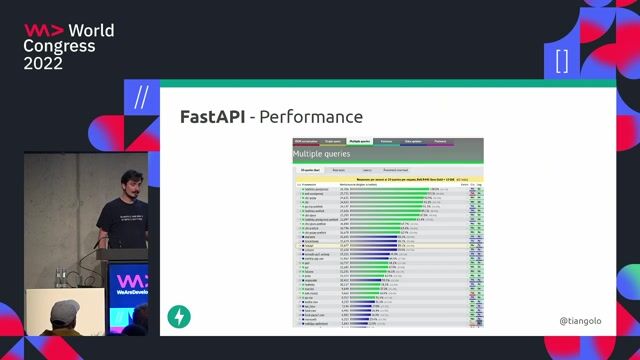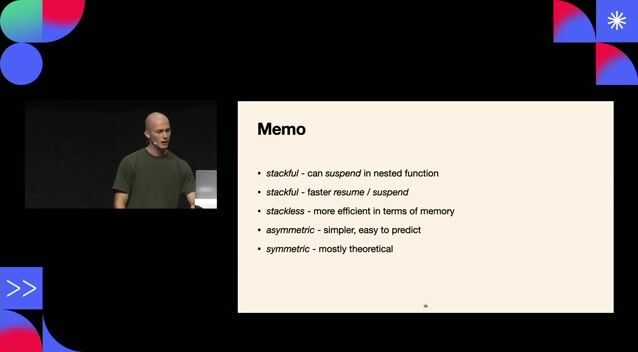Fabian Schindler
Concurrency in Python
#1about 4 minutes
Defining concurrency, parallelism, and multitasking
Key terms like concurrency, parallelism, cooperative multitasking, and preemptive multitasking are defined to build a foundational understanding.
#2about 3 minutes
Weighing the benefits and complexity of multitasking
Multitasking can improve performance and reduce costs, but it introduces complexity, non-determinism, and is limited by Amdahl's Law.
#3about 5 minutes
Understanding the differences between processes and threads
Processes are isolated with higher overhead, while threads are lightweight and share memory, with examples using Python's `threading` and `multiprocessing` modules.
#4about 1 minute
Simplifying concurrency with executor pools
The `concurrent.futures` module provides a high-level interface with `ThreadPoolExecutor` and `ProcessPoolExecutor` to easily apply a function to multiple data items.
#5about 5 minutes
How to prevent data corruption with locks
Race conditions occur when multiple threads access shared data simultaneously, which can be prevented by using a mutex or `threading.Lock` to ensure exclusive access.
#6about 2 minutes
How Python's global interpreter lock affects multithreading
The GIL is a mutex that protects access to Python objects, preventing multiple native threads from executing Python bytecodes at the same time and impacting CPU-bound tasks.
#7about 4 minutes
Overcoming thread limitations with event-driven programming
The C10k problem highlights the inefficiency of a thread-per-client model, leading to event-driven solutions like asynchronous programming to handle many concurrent connections.
#8about 5 minutes
Writing concurrent code with async and await
Python's `async` and `await` keywords enable cooperative multitasking, allowing you to run many tasks concurrently on a single thread using an event loop from the `asyncio` module.
#9about 2 minutes
Building high-performance web services with Starlette
The Starlette web framework demonstrates how `asyncio` can be used to build highly concurrent web servers capable of handling many clients efficiently.
#10about 2 minutes
Q&A on Python's speed and choosing thread counts
Answers to common questions address Python's perceived slowness by working around limitations like the GIL and explain that benchmarking is key to finding the optimal number of threads.
Related jobs
Jobs that call for the skills explored in this talk.
Matching moments

21:20 MIN
Achieving high performance with async support
Intro to FastAPI

07:03 MIN
The evolution from threads to modern concurrency
Concurrency with Go

18:53 MIN
How coroutines fit into modern threading models
Coroutine explained yet again 60 years later

34:36 MIN
Explaining multiprocessing and multithreading with analogies
Devouring APIs with Python

00:26 MIN
Prerequisites and agenda for the FastAPI talk
Build your backend using FastAPI

16:54 MIN
Asynchronous programming with futures and isolates
Dart - a language believed dead, experiences a new bloom

01:33 MIN
Concurrency as a natural model for software design
Concurrency with Go

51:53 MIN
Q&A on concurrency models and developer tools
Devouring APIs with Python
Featured Partners
Related Videos
 59:43
59:43Accelerating Python on GPUs
Paul Graham
 56:19
56:19Concurrency with Go
Frank Müller
 30:36
30:36The Eventloop in JavaScript - How does it work?
Christian Woerz
 52:51
52:51Introduction and pitfalls of Java's new concurrency model
David Vlijmincx
 55:30
55:30Java 21: The Revolution of Virtual Threads - A Deep Dive
Christian Woerz
 21:02
21:02CUDA in Python
Andy Terrel
 30:43
30:43Coroutine explained yet again 60 years later
Mikhail Maslo
 23:14
23:14Multithreading in Javascript: A guide to Web Workers
Dani Coll
Related Articles
View all articles



From learning to earning
Jobs that call for the skills explored in this talk.

Web Developer * - Python und FastAPI
UNITY AG
Lippstadt, Germany
Azure
Julia
Python
FastAPI
Amazon Web Services (AWS)



Technical Lead Developer Python
Future Space S.A.
Municipality of Vitoria-Gasteiz, Spain
Remote
C++
GIT
Python
Docker


Technical Lead Developer Python
Future Space S.A.
Municipality of Madrid, Spain
Remote
C++
GIT
Linux
Python
+1

Technical Lead Developer Python
Future Space S.A.
Municipality of Valencia, Spain
Remote
C++
GIT
Python
Docker

